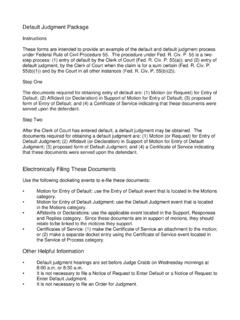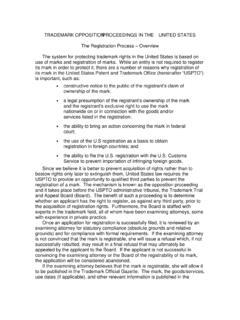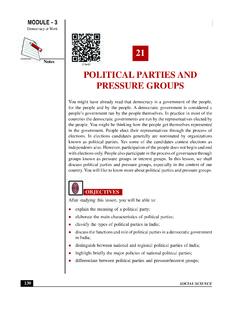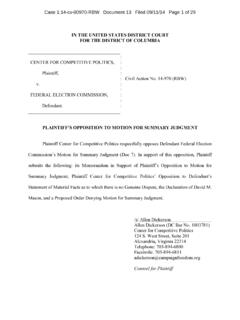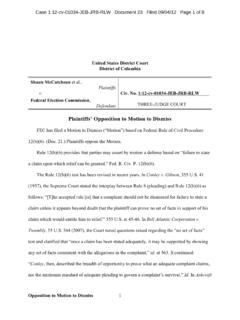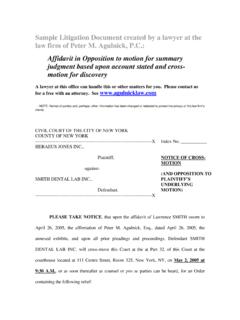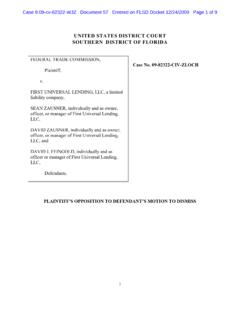Transcription of MOTIONS FOR SUMMARY JUDGMENT
1 1 MOTIONS FOR SUMMARY JUDGMENT These procedures explain how to present and oppose MOTIONS for SUMMARY JUDGMENT . You should follow these procedures and Rule 56 carefully. These procedures require careful preparation of statements of proposed findings of fact. The purpose of these statements of proposed findings of fact is to clearly identify the essential facts material to the motion for SUMMARY JUDGMENT , and to help the court determine if those facts are genuinely disputed. A dispute of fact is genuine if both sides have evidentiary support for their positions.
2 Accordingly, these procedures are also designed to help the court see the evidentiary support for the proposed facts. The court will not search the record for facts or evidence. The fact documents are most useful if the proposed facts, and especially the responses and replies to those facts, are succinctly stated. The fact documents should not be inflated with lengthy argument. If the responses to fairly proposed facts, or the replies to fairly disputed facts, are inappropriately argumentative, then the court may strike the offending response, or in extreme cases, an offending pleading.
3 Because the material facts must be proposed in a statement of proposed facts, it is not necessary to repeat all those facts in the briefs. However, the court will find it helpful to have the background facts concisely stated in an introductory section of the brief. I. The motion for SUMMARY JUDGMENT A. Contents: 1. A motion that clearly states the claims or defenses, or the parts of claims or defenses, for which SUMMARY JUDGMENT is sought. 2. A statement of proposed findings of fact that includes all facts needed to sustain the motion .
4 3. Evidentiary materials that support the proposed facts (see ). 4. A supporting brief. Your brief is the place to make your legal argument, not the place to introduce facts into the record. However, you may find it helpful to include a concise overview of the background facts of the dispute. When you finish the brief, you should confirm that all the dispositive facts that you rely on are stated in the proposed findings of fact document. B. Proposed findings of fact: 1. The purpose of the statement of proposed findings of fact is to clearly identify the material facts and to allow the court to determine whether those facts are genuinely in dispute.
5 2 2. The statement of proposed findings of fact must include all facts necessary to sustain the motion for SUMMARY JUDGMENT , including facts relating to jurisdiction and the identity of the parties . 3. A party must propose each fact in a separate, numbered paragraph, limited as nearly as practical to a single factual proposition. 4. Each factual proposition must be followed by a reference to evidence supporting the proposed fact. The citation must identify where in the record the evidence is located. If a party cites an affidavit of a witness who has submitted multiple affidavits or the deposition of a witness who has been deposed multiple times, then the citation must include the date that the document was created.
6 Where possible, include the docket number. For example: 1. Plaintiff Smith bought six Holstein calves on July 11, 2006. Harold Smith Affidavit, Jan. 6, 2007, , 3. 5. Documents at issue in the case ( , patents, contracts, insurance policies, etc.) should be placed into the SUMMARY JUDGMENT record with a single proposed fact. For example: 1. The contract between Smith and Jones is attached as Exhibit 1 to the Smith Affidavit. Do not propose multiple facts restating the individual provisions of the document. Do not propose facts stating your argument about the meaning of the document.
7 6. Do not propose facts reciting expert opinions or parties arguments. You should address these issues in your brief with citations to the appropriate docket entries. C. Evidence 1. As noted in above, a party must support each proposed finding with admissible evidence. The court will not search the record for evidence. Where possible, provide the docket number for the supporting evidence. 2. A proposed fact can be supported with any of the following evidence: Depositions. Give the name of the witness, the date of the deposition, and page of the transcript of cited deposition testimony.
8 Answers to Interrogatories. State the number of the interrogatory and the party answering it. Admissions made pursuant to Federal Rule of Civil Procedure 36. State the number of the requested admission and the identity of the party to whom it was directed; or Other Admissions. Identify the document, the number of the page, and paragraph of the document in which that admission is made. 3 Affidavits. The page and paragraph number, the name of the affiant, and the date of the affidavit. (Affidavits must be made by persons who have first-hand knowledge and must show that the person making the affidavit is in a position to testify about those facts.)
9 Documentary evidence that is shown to be true and correct, either by an affidavit or by stipulation of the parties . (State exhibit number, page, and paragraph.) II. The response to a motion for SUMMARY JUDGMENT A. Contents: 1. A brief in opposition to the motion for SUMMARY JUDGMENT . 2. A response to each of the moving party s proposed finding of fact. 3. If necessary, additional proposed findings of fact needed to oppose the motion . 4. Evidentiary materials cited in the response to the moving party s facts or in the additional facts proposed by the non-moving party (following the instructions in section above).
10 B. If the responding party proposes its own findings of fact, it should following the procedure in and above. The purpose of additional proposed findings of fact is to supplement the moving party s proposed findings of fact, not to dispute the facts proposed by the moving party. Even if the responding party files additional proposed findings of fact, it must also respond to the each of the moving party s proposed findings of fact. C. The court will conclude that a proposed fact is undisputed unless the responding party explicitly disputes it and either identifies contradictory evidence in the record, or demonstrates that the proponent of the fact does not have admissible evidence to support it.

